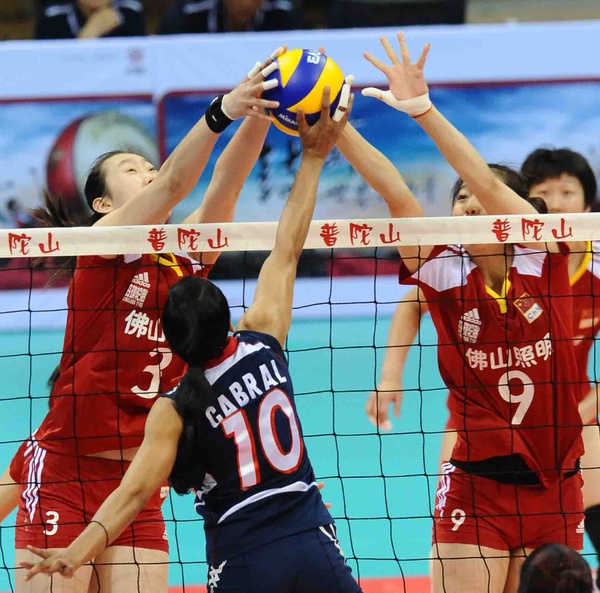



The Chinese Volleyball Team reunited in May this year. The new team consists mostly of new members; all of whom were born after 1985, even though some had the experience of playing in Beijing Olympic Games 2008. After a fifty-day intensive training camp, the China Team revealed their new line up and a huge transformation of strategy in the China International Women’s Volleyball Tournament. With this new line up, the team has won two stages of the China International Women's Volleyball Tournament, the 2nd runner up at the Montreux Volley Masters and the champion of the 9th International Tournament for the Cup of the First President of Russia Boris Yeltsin.
These results reflected the success of the new line-up. So what are the characteristics of the new line-up? Why such changes are needed? Coach Yu Juemin gave us the answers.
Changes begin from the receiver
There are three new players in the team. The first one is attacker Hui Ruoqi, who showed us glimpses of her talent last year but was unfortunately injured in the first match of the World Grand Prix 2010 in Macao. She is now back in the team following her recovery one year after the surgery. The second one is receiver Yang Jie, who had once been selected into China’s volleyball training team, but soon left the team before being recalled again. The last one is Yang Junjing, a wing spiker from the league team Bayi. She receives her first call-up to the national team and now plays a major role in the team.
There are also four veterans in the team, including setter Wei Qiuyue, spiker Wang Yimei, wing spiker Ma Yunwen and libero Zhang Xian. Fans of the Chinese team can immediately recognize the biggest transformation in the team’s line-up: the receivers. Being the most famous receiver in the China team, the recently-retired Zhou Suhong was skillful at every position and was very athletic, even though she was once a main spiker. She was particularly good at receiving serves and attacking, making her the key person in terms of receiving and fast-moving strategy. The national team tried to seek for Zhou’s replacement in the past few years but failed. Hence, Zhou had to rejoin the team and became the final player to retire from the team that won the 2004 Olympics.
After becoming the head coach, Yu Juemin led the coaching team in a series of discussions and evaluations. Based upon the conditions of the players, a new strategy based on using tall receivers has been devised.
Strategy changes from receiving serves
Yu said the idea of the new strategy is based upon the characteristic of the players in the line-up, and this switch of strategy caused a change in the tactics when receiving serves, in which the main attacker must be involved.
New receiver Yang Jie, 192 cm tall and 18 years of age, started learning basic volleyball skills at a very young age from her parents, who are former volleyball players. Her presence compensates the lack of height in the front row, a problem that existed with the short former receivers. However, it would be impractical to demand a tall player to have perfect lower body agility. As a result, Coach Yu would need to strategically select attackers with good receiving skills to be in the main line-up, causing Wang Yimei’s position in the team to be once under threat. Luckily, while Yang Jie has good receiving and defense skills, she is not used to the aggressive attack played at zone 2.After a series of matches and training, it is very encouraging to see the team members cooperate well in the new line-up and gaining more confidence. Meanwhile, Wang Yimei is also working hard at improving her receiving skills and is adjusting to the new line-up and the demand of the strategy. Yu thought the results of the matches prove the efficiency of the line-up and strategy. The team members also state that their confidence has improved and they are getting used to the fast tempo.
The new rule: double libero
The heights of all attackers in the new line-up are or over 190 cm. Even though the team has a height advantage at the net, there are still problems existing in the players’ lower body agility. As soon as FIVB announced the trial out of the new “double libero” regulation, , stating one team can register two liberos during the match, Coach Yu immediately implemented this in his match strategy.
In fact, this change compliments the current status of the team very well. While Zhang Xian is skillful and very experienced, her injury is affecting her movements on the court; where as for 20 year-old Shan Danna, who possesses good basic skills, is full of passion yet lacks the experience in major sports events. With the interchange of two liberos now in play, this can solve the problem of the team while maximizing the team’s all-round attacking and defensive skills, with the veterans leading the new members and the news ones encouraging the veterans to strive for excellence. Yu stated that as long as the authority permits the use of ‘double libero’, China will continue to use this strategy in their games.



